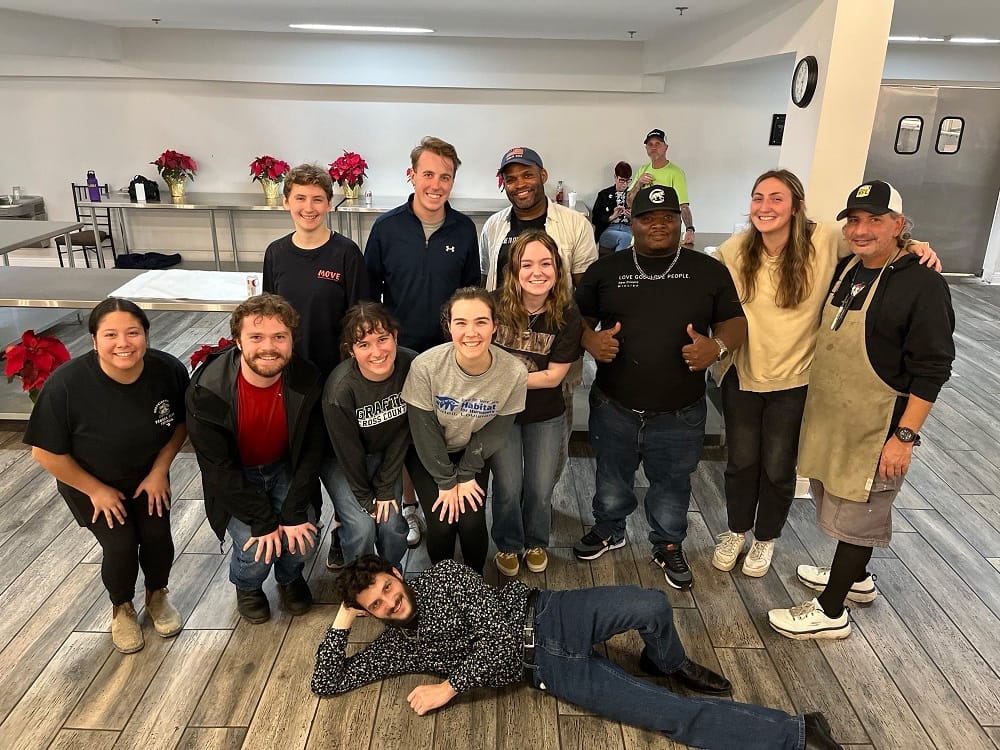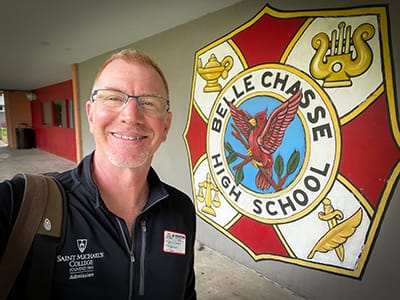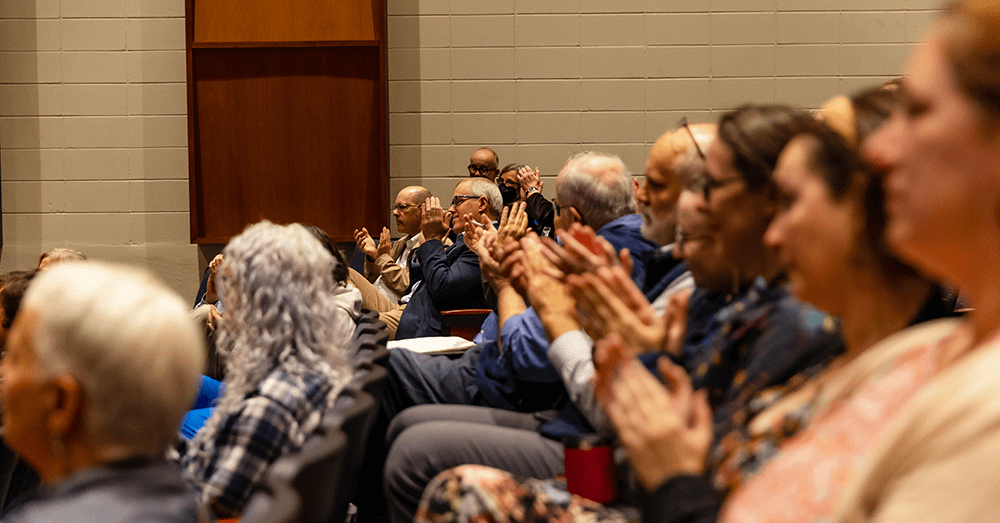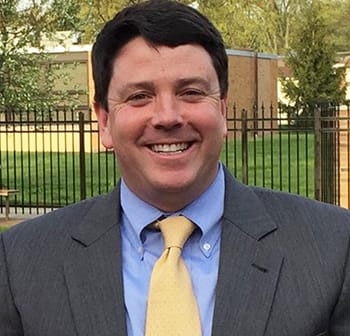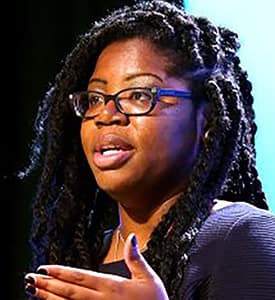Students work chemistry magic on TV, then for crowd
Anything that gets college students up before 5 a.m. and holds their attention until sunset while managing to excite both young kids and their parents is worth learning about and sharing.
So figures David Heroux, Saint Michael’s College associate professor of chemistry, who has a few tricks up his sleeve to promote enthusiasm for science.
Under his direction, members of the College’s Chemistry Club happened into a curiously perfect way to “practice” the fiery, explosive, foamy or sinisterly misty tricks they had planned for a 7 p.m. “Chemistry Magic Show” in McCarthy Recital Hall on Tuesday, March 21. That “practice” involved taking turns on live TV every half hour between 5 a.m. and 8:30 a.m. to show roving TV reporter Alaina Pinto of the local Fox/ABC affiliate’s morning show how this educational brand of showmanship is done.
Anybody up early and tuning in saw – live from a second-floor Cheray Hall lab via a transmitter truck parked outside — such crowd-pleasing “magic” as green and foamy, rapidly expanding “elephant toothpaste,” a miniature “exploding grain silo,” “burning” money that never burns, a team of students smashing deep-frozen carnations into pieces, a loudly-exploding and fiery balloon, and self-inflating balloon-animals dipped in liquid nitrogen.
Later that evening, the group did it all again and scored a big hit for about a hundred children and their parents who turned out along with other Saint Michael’s faculty, staff and students. Viewers of both the morning TV spots and later stage show met an endearing group of poised, funny and impressively knowledgeable young scholars and friends, all talking about why they love studying science at Saint Michael’s: The “family feel,” the fact that it “felt like home” early on, the strength of science faculty and the built-in social group among fellow students all rated mentions.
Heroux explained that when he was a graduate student at Kansas State, he and fellow students did more than 50 similar shows, mostly for youth, so he knew how popular it could be. It motivated him last April to inaugurate the Chemistry Magic Show, which drew close to 75 spectators that first year. Encouraged, this year he recruited even more student-magicians and added new tricks to the canon of tried-and-true favorites.
About 10 students were on stage in McCarthy at different times Tuesday evening, and all the tricks but one went off just as planned — a can-crushing trick came up short when the required vacuum for the can to implode apparently was not fully achieved. “Science doesn’t always work,” Heroux says.
The demonstration table for the tricks was right up front so everybody could see, and the “magicians” super-sized whatever apparatus they could for better visibility. On each trick, an entertaining story led up to the trick, followed by the actual demonstration and then an explanation of the chemistry with a chance for questions and answers — of which there were many from children in the audience. A few tricks featured more than one magician, with a leader joined by an apprentice who can carry on the trick for future years.
Students performing at the evening show who weren’t at the morning session included Ben Peters, a junior chemistry major from Lyndonville, VT, who assisted on several tricks, and Tessa Coleman, a first-year engineering major from Manchester, NH, who engineered something called “the ammonia fountain” involving a large glowing globe of luminal-containing-gas at its peak moment.
“She developed this one, set it up in the lab and has been working the past couple weeks on it, building apparatus and testing it,” Heroux explained, “so now we have a nice new one that can be part of our repertoire since we have the apparatus now.” The big finish for the show involved two large and loudly-exploding hydrogen balloons with colored flame, timed to blow up together.
In these shows, the chemistry is the easy part, Heroux said. “Showmanship — that’s the challenge, standing in front of a crowd when there’s over 100 people, takes practice. And it’s valuable because in a science career we present our results in front of crowds, so there’s some payback for them in doing this. Getting used to talking in front of people is an important skill for science majors.”
Heroux said as a starting point last year, students used some books he has with chemistry tricks in them to find ones they liked, and then adapted their own stories and presentations in order to make them interesting and engaging for audiences. For instance, Zac Minior, a sophomore chemistry major from Bristol, R.I, has a whole routine about “elephant toothpaste” for his imaginary pet elephant that animates his trick with hydrogen peroxide, soap, green dye, and potassium iodide as a catalyst. Minior had one of the later morning slots on TV Tuesday since, as a member of Saint Michael’s Fire & Rescue squad, he had just responded to a car accident on the Interstate at 4 a.m. that same morning and wanted to get a couple hours a sleep. But he took it in stride, saying that’s the norm for a squad member.
Others who saw some airtime even earlier that morning included Jordan Roach, a chemistry major first-year-year from Syracuse, NY, Kaylee Jackson, a sophomore biology major from Saint Albans, VT, Sara Noble, a sophomore biochemistry major from Amherst, NH, Molly Maliska, a sophomore chemistry major from Keene, NH (top photo), and Shannon Conroy, a senior physics and chemistry double-major from California who also is on the varsity ski team and played a few years of club rugby.
Heroux and the students all took pains to explain the science behind each trick in an accurate and educational way, even as they entertained. The students shared some tips on the proper wardrobe for a chemistry-magician: no open-toe shoes, no metal, “the jewelry stays off,” and “make sure you’re nonflammable.”
“The Chemistry Club is a way for these science students to get together, have some fun and relate to each other,” Heroux says. “They’re all very busy students and can relate to each other but still have fun, let off some steam and relax. It’s a real challenge to be a science major, and we have a lot of really great students.”
